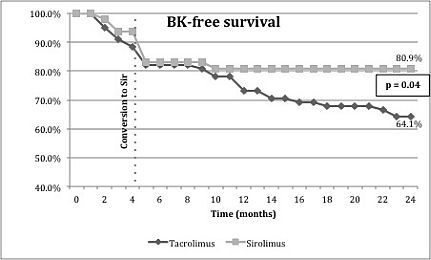Conversion to a Sirolimus-Based Regimen Is Associated with Lower Incidence and Faster Resolution of BK Viremia in Low Risk Kidney Transplant Recipients
Department of Internal Medicine, University of Iowa Hospitals and Clinics, Iowa city, IA
Meeting: 2013 American Transplant Congress
Abstract number: 277
Background: BK nephropathy is a leading cause of early graft loss in kidney transplant recipients. It is not known if a specific immunosuppressive agent is associated with a lower incidence of BK viremia. Methods: Kidney transplant recipients between 2008 and 2011 were included in this analysis. Patients maintained on tacrolimus (Tac), mycophenolate mofetil (MMF) and prednisone were compared to those switched to sirolimus (Sir), MMF and prednisone. Patients with cPRA of less than 20% with no rejection episode within 3 months from transplant were eligible to conversion from Tac to Sir at 3 months post-transplant. Screening for BK viremia was performed at 3, 6, 12 and 24 months after transplant. Cumulative BK-free survival was calculated within 2 years from transplant at 1-month intervals using the Kaplan-Meier method. The rate and time for resolution of BK viremia was obtained at two cutoffs of BK levels: any detectable plasma BK viral load and a plasma BK virus load above 10,000 copies/mL (4 log10 copies/mL). Results: The incidence of any detectable BK viremia and clinically significant BK viremia were 35.9% (28/78) and 17.9% (14/78) respectively in the Tac group and 19.1% (9/47) and 4.3% (2/47) in the Sir group (p=0.04 and p=0.02 respectively).

Both patients on Sir with clinically significant BK viremia were detected to have viremia before conversion. Time to resolution of clinically significant BK viremia was significantly lower in the Sir group compared to the Tac group from onset of viremia (1.9 months and 9.2 respectively, p=0.037) or from peak viremia (1.3 months and 7.5 months respectively, p=0.049). Only two patients developed biopsy-proven BK nephropathy with subsequent graft failure and both were in the Tac group. Conclusion: Conversion to a Sir-based maintenance immunosuppression at 3-6 months from kidney transplantation has the advantage of a lower incidence of BK viremia. Once present, the resolution of BK viremia is faster in a Sir-based regimen, suggesting that Sir might have anti-BK virus properties.
Kalil, R.: Grant/Research Support, Wyeth. Benichou, G.: Grant/Research Support, Wyeth.
To cite this abstract in AMA style:
Tohme F, Kalil R, Thomas C. Conversion to a Sirolimus-Based Regimen Is Associated with Lower Incidence and Faster Resolution of BK Viremia in Low Risk Kidney Transplant Recipients [abstract]. Am J Transplant. 2013; 13 (suppl 5). https://atcmeetingabstracts.com/abstract/conversion-to-a-sirolimus-based-regimen-is-associated-with-lower-incidence-and-faster-resolution-of-bk-viremia-in-low-risk-kidney-transplant-recipients/. Accessed December 14, 2025.« Back to 2013 American Transplant Congress
